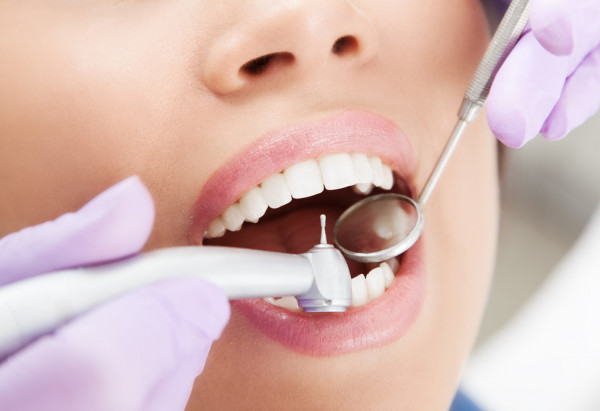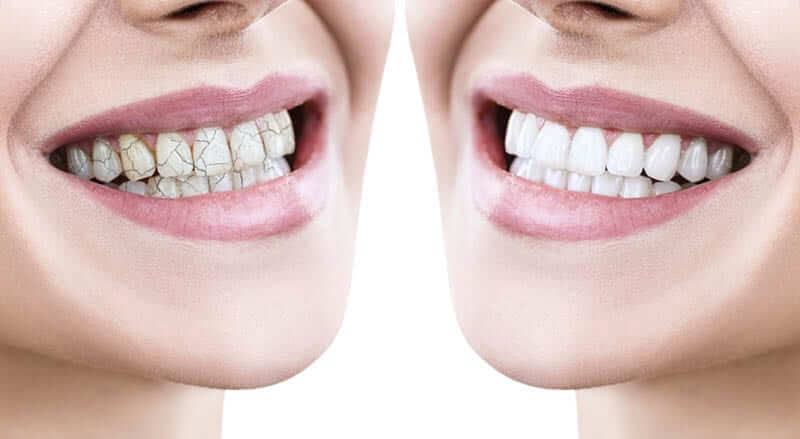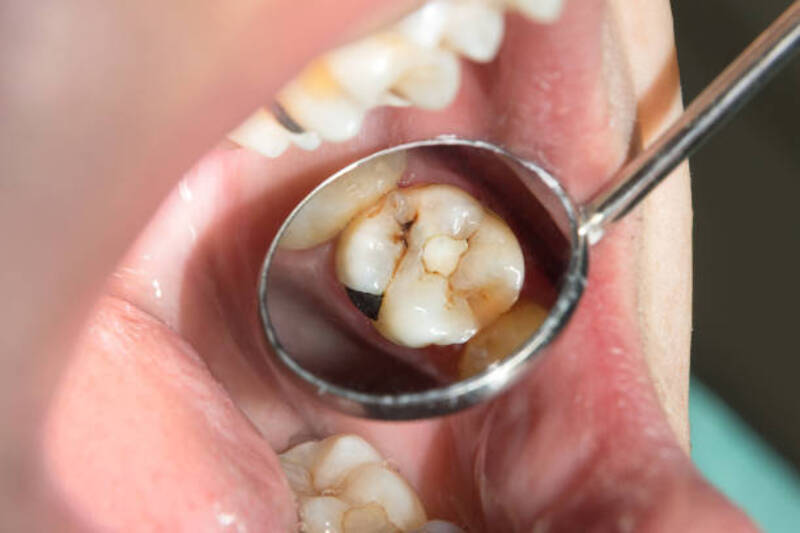Tooth Decay: Causes and Treatment

Contents:
The tooth structure is multilayered; it consists of connective tissue, nerve bundle (pulp), dentin – the tooth’s inner tissue, and is also covered with a hard enamel layer. Enamel protects teeth from aggressive factors: temperature, solid food, some types of food with a high content of organic acids. The enamel layer is composed of 95% calcium hydroxyapatite, which exceeds the strength of the skeleton bone.
Unhealthy habits, poor hygiene, and lack of vitamins changes the tissues’ structure and supply of nutrients. Decayed teeth result from many factors; therefore, special attention should be paid to correcting symptoms and eliminating the pre-existing disease.
What Are the Causes of Tooth Decay?

The leading cause of tooth decay is cavities – a secondary infectious process caused by the destruction of hard and soft tissues due to cariogenic bacteria’s activity. Dental plaque is formed due to insufficient oral hygiene, hardening of the bacterial film, and dissolution of calcium from the dentin matrix.
Tooth decay cannot be considered an independent pathology. It develops as a result of a normal functioning of bodily impairment and an unhealthy diet. Both dental caries and inflammatory diseases of the gums can cause tooth decay can be.
Other causes of tooth decay are:
- complex pathogenesis of dental caries;
- bruxism – teeth grinding during sleep;
- malocclusion, which complicates proper oral hygiene;
- toothpastes with a high concentration of abrasive ingredients;
- frequent whitening, including the use of questionable homemade pastes for tooth whitening whiteness;
- incomplete dental treatment.
Teeth can decay not only due to a medical history but also due to systemic diseases of the internal organs. So, gastritis, ulcerative processes in the gastrointestinal tract, osteoporosis, metabolic disorders, and vitamin deficiency can weaken or change the tooth enamel matrix. Genetic factors play an essential role in cavities development and other medical conditions linked to dental diseases.
Another reason for enamel worn-down is pregnancy. The intake of vitamins and mineral complexes with a high content of calcium, cholecalciferol, B vitamins, folic acid, and vitamin C is essential throughout the gestational period.
However, this is not always enough to prevent the destruction of tooth enamel. Every woman should schedule a dental appointment to keep natural teeth and prevent the spread of infection throughout the body and, if necessary, start dental treatment in the 2nd trimester.
What to Do in Case of a Tooth Decay
Tooth decay is the result of a carious process, the untreated tissue injury. Cavities cause teeth to crumble, crack, or chip. Treatment for decaying teeth should not only begin with dental treatment. The Clinic of Aesthetic Dentistry selects an individual therapy program based on removing cavities as part of the debridement procedure.
Decayed teeth require dental cleaning, fluoride treatment, treatment, or remineralization. Patients are advised to use fluoride toothpastes. To improve the quality of cleaning after each meal, you should clean the interdental spaces with dental floss, use rinses.
The decayed tooth and its surrounding areas should be prepared. Subsequently, a filling material is placed in the formed cavity. All carious teeth are subject to treatment. Without adherence to the protocol for general prevention of the carious process, the disease will progress.
Symptoms of Tooth Decay

Symptoms of decay of the tooth’s coronal part coincide with the carious process at a chalk stain or dentin lesion stage. Patients address with the following complaints:
- the formation of white stripes or spots – enamel demineralization;
- increased sensitivity of enamel when exposed to temperature, in contact with certain food products;
- mild soreness, and when cavities penetrate deep into the dentin, acute pain syndrome appears.
If the root of the tooth or its coronal part decays, the disease is accompanied by severe discomfort, regardless of food intake and, mainly, at night. In the future, patients complain of frequent pain, often radiating to the temporal region, maxillofacial parts, remote from the lesion. Patients experience discomfort in the mouth, foul odor. Tooth root decay leads to disruption of the ligamentous apparatus at the gingival margin, tooth loosening.
The complicated decay process is often accompanied by granuloma formation. Inflammation of the root has adverse consequences, such as osteomyelitis of the jaws.
Is the Tooth Too Damaged to Save?
Damaged teeth can be restored if the root system is intact. The Clinic of Aesthetic Dentistry uses advanced technologies, and its primary goal is to preserve the patient’s natural teeth. To restore teeth, you can rely on the following methods:
- destroyed crown buildup with a composite material;
- placement of intra-root inlays or a pin with its subsequent closure with a zirconium or porcelain-fused-to-metal crown;
- micro-prosthetics by inlay to adjacent teeth or veneer placement;
- implant-retained crowns – if none of the methods is inadvisable to restore or the root cannot be restored.
Restoration of teeth by applying a filling mass is suitable for minor defects: chips, cracks, crumbles. A pivot crown or inlay is indicated when the tooth is decayed by more than one-third. Such a tooth can be restored with composite material and fixed with a post, but the structural strength will be reduced.
Wisdom teeth removal is usually recommended when they are damaged. Considering that third molars do not participate in the chewing process, it is recommended to extract them. Besides, inflammation of the wisdom teeth is complicated by excessive bending of the root canals, making it difficult to cleanse and fill appropriately.
It is recommended to treat baby teeth using the classical method – preparation with a filling, silver coating, or fluoridation.
What Happens if You Do Not Treat Decayed Teeth?
Treatment of dental diseases, including decayed teeth, is necessary to avoid negative consequences. All organs and systems of our body are interconnected, and therefore the disorder of one mechanism entails a violation of other functions. Tooth decay or carious process requires treatment to rule out the following complications:
- The spread of cavities to adjacent teeth and gingival tissue. The abscessed tooth is a source of infection for the rest of the oral cavity’s mucous membranes. In the future, caries becomes extended, mainly if contributory cause exists.
- Increasing the load on adjacent teeth. A decayed aching tooth forces you to limit the chewing load and shift the focus to other teeth.
- Injury to mucous membranes. Uneven edges, chips, and other defects result in trauma or biting into the mouth’s membranes. Damaged teeth injure the tongue and gums, leading to the development of stomatitis.
- Diseases of the digestive tract. The pathogenic microflora penetrates the gastrointestinal tract in a descending way. The patients with existing gastroenterological pathologies such as gastritis, erosion or gastric ulcer, reflux disease, polyps, and other diseases are at risk.
The displacement of the chewing load leads to a change in bite, speech impairment. A partially destroyed tooth does not cause such complications, but tooth extraction and the remaining space may well lead to a noticeable displacement of the dentition in this area.
Tooth Decay Treatment

The basic principle of dental cavities treatment is removing the affected tissues with subsequent filling of the prepared area. In the course of full-mouth debridement, therapeutic measures are performed, and dental plaque is removed. For this purpose, ultrasound, air-abrasive cleaning is used. Techniques help remove bacterial film. The earlier the caries treatment is carried out, the fewer measures are required.
The Clinic of Aesthetic Dentistry uses only the latest materials and equipment to preserve the patients’ natural teeth’ functionality.
Prophylaxis
Dental prevention of tooth damage and decay is reduced to regular hygiene, refusal from bad habits, the formation of healthier sleep and rest routine, and a healthy lifestyle. Complex vitamins and minerals help to balance nutrition. Oral hygiene should be done not only with a brush, toothpaste, and floss. Patients may be advised to use special brushes, irrigators, rinses, etc.
The prognosis for tooth decay is favorable today. Modern dentistry can restore the functionality and integrity of the tooth, even with severe decay. A visit to a dentist at least 2 times a year and adherence to medical recommendations allows you to achieve a good therapeutic effect and avoid serious complications.


